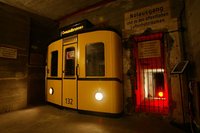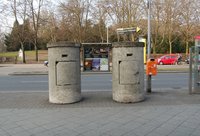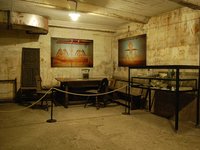Project Berlin Underworlds Museum
BII Railcar 132
For the operation of the first large profile line between Seestrasse and Hallesches Tor (later referred to as Line C and the U6), rolling stock from the Berliner Hoch- und Untergrundbahn Gesellschaft was initially lent to Berliner Nordsüdbahn AG when the line was commissioned (1923). The distance between these narrower coaches (small profile) and the platform was compensated for by using wooden planks on the sides of the carriages. It was not until 1924 that the first large profile cars - BI model - were used here. 74 railcars and 111 sidecars were in operation by 1926. The oval front windows earned the BI model the nickname “tunnel owl”. Additional vehicles were required for the growing subway network. Initial problems with the BI series led to the development of a revised version, the BII series (20 railcars, 57 sidecars). This second B-series was built in 1927/28. The oval windows lent the trains a modern appearance, with the destination now illuminated in the centre above the front door.
Both type B models were used in the Berlin underground network until 1969 on lines C and D, which essentially corresponds to today's U6 and U8. In the last few years of operation, however, the use of the old carriages was limited to providing back-up during peak periods. After their decommissioning, most of the vehicles were lost. Some were scrapped, others were subsequently used as storage, sleeping and recreation rooms or by charities and the military for training purposes.
By the 1930s, disused subway trains were already being repurposed into vehicles for work and maintenance services. Railcar 132 was stationed as an equipment train at Hermannplatz station from 1971 to 1975 and was given the train number 1193.
After 1975, the railcar with a mileage of 1,591,000 kilometres stood idle on the premises of the Britz depot.
In April 1983, the front of railcar 1193 (formerly 132) was cut off and, from summer 1983, it was used as the ticket office for the "Multivision Berlin Show" (a 180° cinema with a promotional film about the city of Berlin) in the Europa Centre. After about 10 years the Berlin Multivision Show closed, and the front of the car was kept as decoration for subsequent retail tenants. Unfortunately, the front of the carriage was repainted blue, which is not typical for the Berlin underground.
In summer 2005, members of Berlin Underworlds became aware of this train front and were already racking their brains over possible uses within the Association. In February 2006, the situation suddenly became topical, as the section of the building in question was to make way for a new construction. Over the course of two days, four Underworlders succeeded in dismantling the "cash box", which was firmly bolted to the wall and floor. After dismantling the original wooden roof and smaller details (whistle, destination display and grips), and the removal of the interior panelling, the front could be cut accordingly for its new use as an exhibit in the Underworlds Museum. The narrow stairs and room openings in the Underworlds Museum did not allow for a longer train front, so we had to leave a good two metres behind in the Europa Centre.
The front of the 132 BII railcar was set up in the Berlin Underworlds Museum as an exhibit for the "GN railway" themed room. After assembling the car and repainting it its original yellow colour, the carriage also got back its former number, 132.
A few metres below, on the tracks of today's U8, this carriage made its rounds on line D countless times until 1969 between the then termini of Gesundbrunnen and Leinestrasse. We have thus brought a piece of real history from the year 1928 into our GN railway showroom, bridging the gap between the U8 and our Association museum.
Today, there are only a few remaining examples of the BII model. For example, the Berlin subway consortium keeps a four-part museum train for special trips, which comprises the 131 railcar, among other things. Today, car 133 serves as an information room in the Südgelände nature park (Priesterweg S-Bahn station).
The one-man bunkers from Frohnau
In spring 1999, members of the Association spotted a newspaper advertisement stating that two one-man bunkers were to be given away. Since there were no appropriate references to our Association’s activities at that time at Gesundbrunnen subway station, the idea came about to place both bunkers in front of the southern entrance to the subway station. An information board would also be erected. Upon contacting the owners, a family from Berlin-Frohnau, we learned that we could pick up the one-man bunkers at our own expense and that we should hurry because there were other interested parties. Without further ado, the Karl Altendorff company rented us a truck with a crane to load the bunkers. It became quickly apparent that this would be no easy task.
Beforehand, the entrance to the property had to be surveyed to ensure that the crane truck could pass through this bottleneck. Planks as thick as arms, which were used to cover the path through the garden, were also intended to prevent the loaded truck from sinking. The excavation and uncovering of the bunkers also caused difficulties. They were not just stuck in the ground, but also anchored in a thick layer of compressed concrete. When pulling out the one-man bunker, which together with the compressed concrete ring weighed about 3.8 tons, the wooden planks gave way under the supporting hydraulics of the crane truck, which sank deeply into the soft garden soil, and broke in two with a loud crack. But after some tugging, the bunkers were removed.
When both bunkers were finally loaded, they still had to be properly lashed so that they did not fall off during the journey. When driving through the entrance to the property, the crane truck, whose weight had now almost doubled, sank almost 10 centimeter deep, leaving two wide ruts. The family was nevertheless visibly glad to be rid of the concrete monstrosities. Until a permit was issued, both one-man bunkers were allowed to be temporarily stored on the premises of the Wedding Horticultural Office. They were installed in their current location in July 2000. Five different types of one-man bunkers are known to us from the Berlin area.
The "specimens" presented here are probably among the last of their kind. They have a height of 2.20 metres and an outer diameter of 1.20 metres. The wall thickness of spun reinforced concrete is 15 centimeter, the weight is about 2.8 tons. During the Second World War, one-man bunkers were mainly used as protection for fire guards in industrial areas and could only be destroyed by a direct hit.
Exhibits from the "Fahrerbunker" (drivers’ bunker)
Behind the houses of the guard detail on "Hermann-Göring-Strasse", today's Ebertstrasse, there was a large underground car park where the fleet of vehicles of the New Reich Chancellery was parked and maintained. In the winter of 1943/44, the underground car park was equipped with a smaller bunker to protect the motor pool as, even at that time, normal air-raid shelters were no longer considered safe. Around 40 people could fit into the eight small bunker rooms. During the final battles for Berlin, extensive stocks of ammunition were stored in the "drivers’ bunker", including mainly hand grenades, bazookas and infantry ammunition. In contrast to the so-called "Führer Bunker", the drivers’ bunker remained untouched for decades, among other things because the entrance was buried by a direct hit during the fierce fighting for the government quarter and because the facility had been located in the middle of the border area since August 13th, 1961, when the Berlin Wall was built.
It was not until 1990 that the bunker was rediscovered during ammunition recovery work for the open-air concert, "The Wall". The wall paintings in particular, which glorify the NS-ideology in a bizarre way, caused a worldwide sensation. In 1992 and 1996 the bunker was thoroughly investigated and surveyed by the State Archaeological Office under the direction of Alfred Kerndl and later by members of the Berlin Underworlds Association.
The finds recovered by the Museum of Prehistory and Early History as well as the photographs from the interior of the site can now be viewed in the Berlin Underworlds Museum as part of Tour 1.
instagram takipçi satın al - instagram takipçi satın al mobil ödeme - takipçi satın al
bahis siteleri - deneme bonusu - casino siteleri
bahis siteleri - kaçak bahis - canlı bahis




